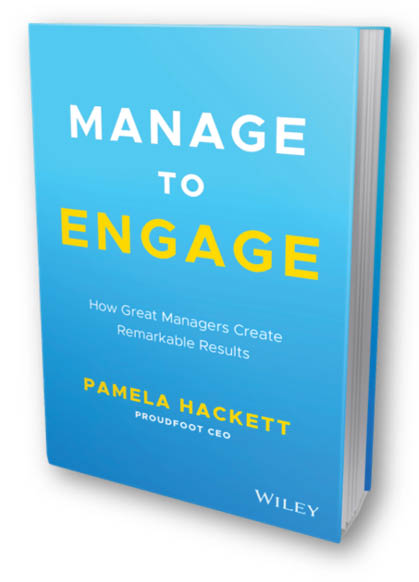
Digital or not, most transformations do not cross the finish line. You might achieve your numbers for a while, but then people slip back to the old ways of working and nothing sticks, leaving you to solve the same problem again. In order to outdo poor transformation and engagement stats, we must manage to engage because the future of business is (still) people.
We have all heard the stats: most transformations fail. Digital or not, 70 per cent of organisational transformations do not cross the finish line. The investment is lost. Results are elusive. And complaints abound. You might achieve your numbers for a while, but then people slip back to the old ways of working and nothing sticks, leaving you to solve the same problem again.
Even worse are the stats on employee engagement. As few as two out of 10 employees are all in. More than half would jump ship for another job if given a chance. Pre- and post-pandemic, the stats remain the same-bad!
Yet for all the bad news, there is some light. Roughly one in four high-performing companies do achieve transformation and create sustainable change and improvement. And about one in every four to five highperforming employees are more than often engaged.
So, what do they have in common, and what can we learn from them?
Proudfoot has been conducting operational assessments and implementing solutions for eight decades, including more than 30,000 assessments; 20,000 implementation programs; and over one million coached leaders. The takeaways from these bootson-the-ground projects are clear. High performing businesses and their teams have two things in common:
1. Management models, operational models, and business models get equal time
High-performing companies realise they need to focus on management, operational, and business models to deliver a safe, productive, sustainable, and engaging operation. They look at the business through each of the three models:
Management. How work, people, and data are led, and how decisions are made.
Operational. How work, people, and data are organised and managed.
Business How work, people, and data are monetised.
In contrast, within struggling companies, not enough time is spent on management models—how they engage, enable, and energise people to perform work and make money from it. And not enough time is spent optimising operations to ensure that expected, future, and digital outcomes are achieved and sustained.
Why do these companies miss the mark? Because employee engagement is often seen as an HR, policy, or perks discussion rather than a skillset built into the DNA of leaders. Likewise, technology is often seen as a shiny, new toy rather than a tool to be leveraged.
2. Leaders at every level are active in the business
The other crucial finding is that high performing companies have leaders at every level who are actively involved in the business, get in the game, and know their teams well. These leaders routinely connect with their teams to engage their people and build workplaces that enable employees to perform at their best. And when you do that, you create a more productive workplace. Engagement and productivity go hand in hand.
The best leaders lift their noses out of their devices and reporting, get out on the floor (or get on Zoom), and prioritise human connection as they look, listen, and learn about what is happening in their business. They focus on their teams—where the work gets done—to remove barriers and continuously improve their operations, team performance, and outcomes. The best leaders, particularly frontline leaders, manage to engage.
Nothing moves until your people move
So, it stands to reason that the most vital component to get right in your business is the foundation: you must humanise. And that means understanding what triggers engagement and then calibrating this to your people. One size does not fit all. Management systems and processes must be dictated by what drives people to perform. They must reflect how much we value people and recognise that people drive performance.
Additionally, the basics of operational excellence also count. People and resources need to be assigned at the optimum viable cost base, safely, and sustainably.
It is time to rethink your management models
The economic crisis sparked by COVID-19 caused many firms to protect their cash. Of the three areas that impact EBITDA—cash, cost, and growth—cash and cost have clearly been omnipresent. But it is not enough. You cannot reinvent your cost base and conserve your cash without rethinking your management models. If you do not, you will not grow. If your processes are efficient but your teams are disengaged, if your operating model is cost-effective but switches people off, if your business model is brilliant but loses your people, you win the productivity war temporarily but lose the engagement war permanently.
You need to map out your management models as much as you do your operational and business models. You need to revisit how you get work done and what you expect people to get done; how you find, select, hire, retain, manage, reward, and lead people; how you organise and motivate people, and how you make decisions with your people about what needs to be accomplished and how. All of this needs to be reimagined if you are to build a healthy and fit company—one that is engaged and productive. You need to humanise, optimise, and digitise. All are necessary, but none are sufficient in isolation.
Start with the MI9
A scorecard that can help you review your management model is the Management Innovation 9 (MI9), also known as /My Nine’. It lays out nine triggers leaders have at their fingertips to better engage their people:
Fair trade: Are you a fair manager? Do you provide a fair trade? Are you genuine, and do you give people a fair go?
Cause: Do your people know and understand how they contribute to your business? Do you convert vision into verbs? Do you help people see their value?
A clean and meaningful infrastructure: Do you know what is getting in people’s way at work, and are you doing anything about it?
Confidence: Do you consider it a priority to remove the doubt that creeps into people’s minds at work? Do you close the gap on silence? Are you conscious of your role as chief confidence builder?
Connection: Do you manage and lead individuals? Do you take the time to know and understand each person as well as the team as a whole?
Collaboration: Are you willing to break down the artificial walls in your business, foster wide collaboration, and invite new faces to the table?
Community: Do you proactively look for opportunities to build community into your workplace? Have you sought to create communities of spirit, expertise, and knowledge? Do your practices give people a sense of belonging?
Capability: How good are you at letting people learn? Do you also learn from your people? Do you cultivate markets of knowledge ready for exchange? Do you offer a balance of experience and skill mastery? Do people learn from one another?
Freedom: Are you serious about removing the chains that confine people? Do employees have a voice? Do you get out of their way and let them be remarkable?
COVID-19 enabled us to recognise that great things happen at the intersection of people and technology. During this time, we saw change happen at lightning speed. We also saw that change required the power of people. So, if we want to outdo poor transformation and engagement stats, we must manage to engage because the future of business is (still) people.
Log In or become an AIMA member to read more articles
